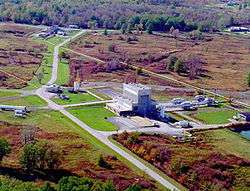Spacecraft Propulsion Research Facility
The Spacecraft Propulsion Research Facility, now known as the In-Space Propulsion Facility, is (according to NASA), the "world’s only facility capable of testing full-scale upper-stage launch vehicles and rocket engines under simulated high-altitude conditions." The facility, located at NASA's Plum Brook Station of the Glenn Research Center near Sandusky, Ohio, was built in 1968. Its first major use was for testing stages of the Centaur Rocket, which was used to launch some of America's most important space probes.[2] The facility was designated a National Historic Landmark in 1985.[1]
Spacecraft Propulsion Research Facility (B-2) | |
 Facility aerial view | |
  | |
| Location | Erie County, Ohio |
|---|---|
| Coordinates | 41°22′1″N 82°41′1″W |
| Area | less than one acre |
| Built | 1968 |
| Architect | NASA |
| NRHP reference No. | 85002802[1] |
| Added to NRHP | October 3, 1985 |
Description and history
NASA's Plum Brook Station is located off Taylor Road, between Bloomingville and Bogart, south of Sandusky, Ohio. This remote site was established by NASA to facilitate large-scale testing of dangerous equipment. The In-Space Propulsion Facility, designed to perform full-scale test-firing of large rockets, is one of several facilities at the station. It consists of a building housing its main test chamber, a test equipment building, and fueling and exhaust facilities associated with the firing of rockets within the test chamber. The main chamber is a steel cylinder designed to house test subjects up to 22 feet (6.7 m) in diameter and 50 feet (15 m) in height. A door 27 feet (8.2 m) high provides access for bringing equipment into the chamber, which is equipped with several viewports through which remote viewing apparatus can observe the test. The chamber has a cooling wall capable of being maintained at −320 °F (−195.6 °C), cooled by liquid nitrogen. Infrared lamps simulate radiation environments found in space, and the chamber is capable of being having its pressure reduced to the equivalent of 100 miles (160 km) of altitude.[3] Engines in the test chamber can generate a thrust up to 400,000 pounds.
The facility was built in 1968 as part of the Centaur development. These upper-stage rockets (launched on Atlas V first stages) needed to be capable of firing at high altitude to launch their payloads out of Earth orbit. More than ten tests of Centaur rockets here enabled the later successful launches in the Pioneer, Voyager, and Viking programs.
See also
References
- "National Register Information System". National Register of Historic Places. National Park Service. January 23, 2007.
- National Historic Landmark listing Archived 2011-06-06 at the Wayback Machine
- "NHL nomination for Spacecraft Propulsion Research Facility". National Park Service. Retrieved 2018-03-24.